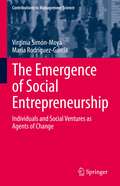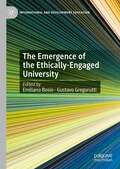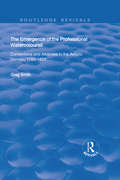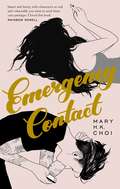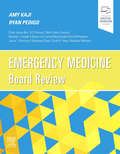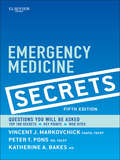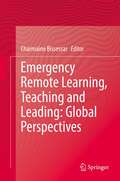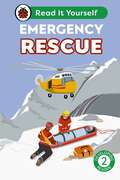- Table View
- List View
The Emergence of Social Entrepreneurship: Individuals and Social Ventures as Agents of Change (Contributions to Management Science)
by Virginia Simón-Moya María Rodríguez-GarcíaThe rise of hybrid ventures is proof that another way of doing business is possible. Many developments in the last 15 years highlight the significance of social entrepreneurship: the 2006 Nobel Peace Prize to Grameen Bank, the efforts of scholars in studying social ventures, and the new academic programs at Ivy League universities, as well as the creation of indices such as the United Nations Human Development Index to measure non-economic issues. This book portrays these as strong indicators to support the development and sustenance of a market-based economy that also imbibes social progress and human values. This book emphasizes that awareness of the conditions under which social start-ups emerge is crucial. The authors provide a thorough and empirical analysis of the emergence of social entrepreneurship using the Global Entrepreneurship Monitor (GEM) data as well as case studies from practice. From the perspective of individuals, they examine the most important characteristics of social entrepreneurs, and from a macro perspective, social ventures are studied as agents of change. A handpicked collection of successful cases of social ventures also provides the reader with an awareness of the best practices.
The Emergence of Teacher Education in Zambia (Emerald Studies in Teacher Preparation in National and Global Contexts)
by Brendan P. CarmodyThis historical narrative focuses on the emergence of teacher education in Zambia. Providing archival material, diverse interpretations, local voices through interview and email, it engages the reader in a complex recipe of viewpoints. It rehearses how teacher education developed from a form of apprenticeship in remote villages to the more centralized 'normal school' in colonial times through to colleges with nationwide catchment and more recently to university accreditation. Schooling as an avenue to social mobility and nation building, the challenges of student centred-learning and the development of teachers as professionals are central themes throughout the text. Also analysed is the nature of education offered at different times and how the teacher and his/her education reflect this, arguing the need for a fundamentally new philosophy of education and a mode of teacher formation in line with it. This book will be an invaluable tool for undergraduate and postgraduate education students, researchers, and practitioners alike, both within and beyond the Zambian and African contexts. It provides rich historical data from which policy makers, historians, and teaching professionals can explore the re-conceptualisation of the role of the teacher as professional rather than as civil servant. Designed to stimulate critical discussion so as to enhance understanding of what effective teaching and teacher education entail and framed by long-term first-hand experience of teacher education in Zambia.
The Emergence of Teacher Education in Zambia (Emerald Studies in Teacher Preparation in National and Global Contexts)
by Brendan P. CarmodyThis historical narrative focuses on the emergence of teacher education in Zambia. Providing archival material, diverse interpretations, local voices through interview and email, it engages the reader in a complex recipe of viewpoints. It rehearses how teacher education developed from a form of apprenticeship in remote villages to the more centralized 'normal school' in colonial times through to colleges with nationwide catchment and more recently to university accreditation. Schooling as an avenue to social mobility and nation building, the challenges of student centred-learning and the development of teachers as professionals are central themes throughout the text. Also analysed is the nature of education offered at different times and how the teacher and his/her education reflect this, arguing the need for a fundamentally new philosophy of education and a mode of teacher formation in line with it. This book will be an invaluable tool for undergraduate and postgraduate education students, researchers, and practitioners alike, both within and beyond the Zambian and African contexts. It provides rich historical data from which policy makers, historians, and teaching professionals can explore the re-conceptualisation of the role of the teacher as professional rather than as civil servant. Designed to stimulate critical discussion so as to enhance understanding of what effective teaching and teacher education entail and framed by long-term first-hand experience of teacher education in Zambia.
The Emergence of the American University
by Laurence R. VeyseyThe American university of today is the product of a sudden, mainly unplanned period of development at the close of the nineteenth and the beginning of the twentieth centuries. At that time the university, and with it a recognizably modern style of academic life, emerged to eclipse the older, religiously oriented college. Precedents, formal and informal, were then set which have affected the soul of professor, student, and academic administrator ever since. What did the men living in this formative period want the American university to become? How did they differ in defining the ideal university? And why did the institution acquire a form that only partially corresponded with these definitions? These are the questions Mr. Veysey seeks to answer.
The Emergence of the Ethically-Engaged University (International and Development Education)
by Emiliano Bosio Gustavo GregoruttiThis edited volume examines the role of the modern university as a public good institution ethically engaged in social transformation. Featuring contributions from internationally recognized scholars across both the Global North and South, this collection contexualizes issues in higher education such as community engagement, service learning, citizenship and civic responsibility both locally and globally (e.g., local, regional, national, and global engagement). Each chapter addresses the intangible, multifaceted dimensions of the relationships, community impact, and knowledge generation associated with community collaborations. In this way, the volume contributes towards the possibility of re-imagining the role of the modern university beyond a market-oriented, passive, and de-solidarized practices towards a more ethically engaged paradigm based on principles of mutuality, reciprocity and social responsibility.
The Emergence of the Professional Watercolourist: Contentions and Alliances in the Artistic Domain, 1760–1824 (Routledge Revivals)
by Greg SmithThis title was first published in 2002: Draw ing on extensive primary research, Greg Smith describes the shifting cultural identities of the English watercolour, and the English watercolourist, at the end of the eighteenth and the beginning of the nineteenth century. His convincing narrative of the conflicts and alliances that marked the history of the medium and its practitioners during this period includes careful detail about the broader artistic context within which watercolours were produced, acquired and discussed. Smith calls into question many of the received assumptions about the history of watercolour painting. His account exposes the unsatisfactory nature of the traditional narrative of watercolour painting’s development into a ’high’ art form, which has tended to offer a celebratory focus on the innovations and genius of individual practitioners such as Turner and Girtin, rather than detailing the anxieties and aspirations that characterized the ambivalent status of the watercolourist. The Emergence of the Professional Watercolourist is published with the assistance of the Paul Mellon Foundation.
The Emergence of the Professional Watercolourist: Contentions and Alliances in the Artistic Domain, 1760–1824 (Routledge Revivals)
by Greg SmithThis title was first published in 2002: Draw ing on extensive primary research, Greg Smith describes the shifting cultural identities of the English watercolour, and the English watercolourist, at the end of the eighteenth and the beginning of the nineteenth century. His convincing narrative of the conflicts and alliances that marked the history of the medium and its practitioners during this period includes careful detail about the broader artistic context within which watercolours were produced, acquired and discussed. Smith calls into question many of the received assumptions about the history of watercolour painting. His account exposes the unsatisfactory nature of the traditional narrative of watercolour painting’s development into a ’high’ art form, which has tended to offer a celebratory focus on the innovations and genius of individual practitioners such as Turner and Girtin, rather than detailing the anxieties and aspirations that characterized the ambivalent status of the watercolourist. The Emergence of the Professional Watercolourist is published with the assistance of the Paul Mellon Foundation.
The Emergence of Yehud in the Persian Period: A Social and Demographic Study (The Library of Hebrew Bible/Old Testament Studies)
by Charles E. CarterA long-awaited and much-needed comprehensive analysis of the material evidence concerning Persian-period Judah. Carter analyses the settlement pattern and population distribution of the province, using both excavations and archaeological surveys. His meticulous examination arrives at a rather low estimate of the population during this period, on the basis of which he examines Yehud's socio-economic setting and considers the implications of a small Yehud for some of the prominent theories concerning the province in the Persian-period.
Emergency Contact
by Mary ChoiFrom debut author Mary H.K. Choi comes a compulsively readable novel that shows young love in all its awkward glory - perfect for fans of Eleanor & Park and To All the Boys I've Loved Before. For Penny Lee high school was a total non-event. Her friends were okay, her grades were fine, and while she somehow managed to land a boyfriend, he doesn't actually know anything about her. When Penny heads to college in Austin, Texas, to learn how to become a writer, it's seventy-nine miles and a million light years away from everything she can't wait to leave behind. Sam's stuck. Literally, figuratively, emotionally, financially. He works at a café and sleeps there too, on a mattress on the floor of an empty storage room upstairs. He knows that this is the god-awful chapter of his life that will serve as inspiration for when he's a famous movie director but right this second the seventeen bucks in his bank account and his dying laptop are really testing him. When Sam and Penny cross paths it's less meet-cute and more a collision of unbearable awkwardness. Still, they swap numbers and stay in touch - via text - and soon become digitally inseparable, sharing their deepest anxieties and secret dreams without the humiliating weirdness of having to see each other.
Emergency Medicine Board Review E-Book
by Amy Kaji Ryan A. PedigoIncrease your opportunity for first-time success on the challenging emergency medicine board exam with this authoritative, highly illustrated review tool! Written and edited by contributors from the UCLA-affiliated residency programs, Emergency Medicine Board Review covers the full range of disorders, procedures, skills, and other core competencies that the emergency medicine physician needs to know. A bulleted, easy-to-read format supported by hundreds of high-quality images and questions make it the most efficient and effective way to study for certification and MOC exams and prepare for clinical practice.Contains approximately 500 board-style, multiple-choice questions with full, discursive answers, and more than 300 clinical photos for effective visual learning. Features up-to-date content in a streamlined, highly focused format with questions directly related to the board exam, both in print and online. Covers all areas of the Emergency Medicine Model for certification and in-service exams, including devices (AICD, LVAD, pacemakers), infectious disease, pediatrics, rashes, toxicology, trauma, and more. Includes key procedures such as airway management; neonatal, pediatric, adult cardiac arrest; vascular access; wound management; ultrasound; and procedural sedation.
Emergency Medicine Secrets E-Book: Emergency Medicine Secrets (Secrets)
by Vincent J. MarkovchickEmergency Medicine Secrets, 5th Edition, by Drs. Vincent J. Markovchick, Peter T. Pons, and Katherine M. Bakes, gives you the emergency medicine answers you need for successful emergency medicine care. Featuring new chapters and revised content to bring you completely up to date, this dependable review and reference retains its engaging question-and-answer format.Get the most return for your study time with the proven Secrets® format – concise, easy to read, and highly effective. Skim the "Top 100 Secrets" and "Key Points" boxes for a fast overview of the secrets you must know for success in practice. Enjoy faster, easier review and master the top issues in emergency medicine with mnemonics, lists, quick-reference tables, and an informal tone that sets this review book apart from the rest. Carry it with you in your lab coat pocket for quick reference or review anytime, anywhere. Understand the latest concepts in emergency medicine with all-new chapters such as Evidence-based Rational Use of Diagnostic Imaging, Common Drugs of Abuse, and One Pill Can Kill, plus extensive updates on Asthma • COPD and Pneumonia • Esophagus and Stomach Disorders • Soft-Tissue Infections • Evaluation of Fever in Children Younger than Three • Seizures in Infancy and Childhood • Acute Respiratory Disorders in Children • Evaluation of Child Abuse • Procedural Sedation and Analgesia of the Pediatric Patient • Bites and Stings • Sexual Assault • Third Trimester Complications and Delivery • Abdominal Trauma • Burns • Domestic Violence • EMTALA, JC, and HIPAA • and Medical Oversight and Disaster Management Stay current with thorough updates to both text and references in all chapters, and related websites added to the bibliography.
Emergency Medicine Secrets E-Book: Emergency Medicine Secrets (Secrets)
by Vincent J. MarkovchickFor 30 years, the highly regarded Secrets Series® has provided students and practitioners in all areas of health care with concise, focused, and engaging resources for quick reference and exam review. The 6th Edition of Emergency Medicine Secrets, by Drs. Vincent J. Markovchick, Peter T. Pons, Katherine M. Bakes, and Jennie A. Buchanan, features the Secrets’ popular question-and-answer format that also includes lists, mnemonics, tables, and an informal tone – making reference and review quick, easy, and enjoyable.Top 100 Secrets and Key Points boxes provide a fast overview of the secrets you must know for success in practice. The proven Secrets® format gives you the most return for your study time – concise, easy to read, engaging, and highly effective. Portable size makes it easy to carry with you for quick reference or review anywhere, anytime. Thorough updates keep you current with what’s new in emergency medicine.
Emergency Remote Learning, Teaching and Leading: Global Perspectives
by Charmaine BissessarThis book exemplifies the challenges and successes of online learning, teaching and leading in times of crises. It helps shed light on the issues facing online and face-to-face practitioners having to cope with the COVID-19 pandemic and continue education within the confines of a specific interface. The volume includes new research and information, which can be built upon in the coming months and years depending on how long the pandemic persists. Therefore, it adds a geometric dimension to the current research on online teaching, learning and leading with emphasis on what can be done during a pandemic. The book is beneficial because it is timely and significant based on current happenings in the world. Its findings contribute to expansive research on online learning, teaching and leading but with a focus on emergency education. The information contained in the book is significant to different regions in the world such as the Caribbean, UK, USA, Greece, Mauritius inter alia. The book is of interest to teachers, students, parents, leaders and anyone who wants to adopt online education.
Emergency Remote Teaching and Beyond: Voices from World Language Teachers and Researchers
by Julian ChenThis timely volume addresses issues pertaining to language teaching, learning and research during the pandemic. In times of a global emergency, the aftermath of emergency remote teaching (ERT) cannot be ignored. The question of how language educators and researchers unleash creativity and employ strategies vis-à-vis ERT still remains to be answered. With practitioners in mind, it covers a broad spectrum of educational settings across continents, target languages and methodologies. Specifically, it reveals viable ways of utilizing digital technologies to bypass social distancing while highlighting the pitfalls and challenges associated with crisis teaching and research. This volume comprises two parts: Teacher Voice vicariously transports readers to practitioners’ compelling stories of how teacher resilience, identity and professional development are crystallized in adaptive pedagogy, online teaching practicum, virtual study programs and communities of practice during ERT. The second part, Researcher Corner, showcases innovative approaches for both novice and seasoned researchers to upskill their toolkits, ranging from case study research and mixed methods designs, to auto- and virtual ethnography and social media research. The array of food for thought provides a positive outlook and inspires us to rethink our current practices and future directions in the post-COVID world. Regardless of their backgrounds and experiences, readers will be able to relate to this accessible volume that harmonizes research and practice, and speaks from the hearts of all the contributors.
Emergency Rescue: Read It Yourself - Level 2 Developing Reader (Read It Yourself)
by LadybirdLearn about the real-life superheroes who help us in an emergency! From the police to the coastguard, the emergency services have got our backs. Join the rescue crews as they save lives, catch criminals and heal injuries in this colourful, fact-filled book.Emergency Rescue is from Developing Reader Level 2 and is ideal for readers aged from 5+ who can read short, simple sentences with help.Each book has been carefully checked by educational and subject consultants and includes comprehension puzzles, book band information, and tips for helping children with their reading.With five levels to take children from first phonics to fluent reading and a wide range of different stories and topics for every interest, Read It Yourself helps children build their confidence and begin reading for pleasure.
Emergency Sleepover (The Sleepover Club #29)
by Fiona CummingsJoin the Sleepover Club: Frankie, Kenny, Felicity, Rosie and Lyndsey, five girls who want to have fun – but who always end up in mischief.
Emergent Learning for Wisdom
by M. TaylorThe new millennium presents us with unexpected events that challenge us to think and act in different ways. Meeting these challenges requires creation of knowledge and development of wisdom. This book draws together forty years of scholarship, practice and original research, to catalyze our expertise in learning about what we don't know.
Emergent Practices and Material Conditions in Learning and Teaching with Technologies: Emerging Practices
by Isa Jahnke Teresa Cerratto PargmanThis book explores the complexities of interacting with digital technologies in the everyday flow of practices in schools, museums, and the home. In particular, the authors pay attention to the material conditions of such practices via the exploration of media discourses on information and communication technologies in the classroom; the ongoing digitization of the school; the use of video chat for language learning; the instantiation of CrossActionSpaces in an urban science classrooms; the development of symbolic technologies such as the Carbon Footprint Calculator; the design of apps and virtual museums for learning science; the use of text message tools for collaborative learning in teacher education and the design, implementation, and evaluation of Augmented Reality apps in outdoor learning. The book is grounded in case studies presented by scholars at the workshop, “Changing Teaching and Learning Practices in Schools with Tablet-Mediated Collaborative Learning: Nordic, European and International Views” and the workshop “Emergent Practices and Material Conditions in Tablet-mediated Collaborative Learning and Teaching” both of which have been held at the Computer-Supported Collaborative Learning conference (CSCL). This volume brings together inspirational and high-quality chapters that raise a range of important ideas and showcase the importance of looking beyond technology-enhanced learning. Taken together, this volume unpacks a variety of everyday situations by engaging with what is really happening with digital technologies rather than what is expected to happen with them in educational settings. The take-away message is a call for research on learning, teaching, and digital technologies that enables engagement with the materiality of educational practices and, in particular, their constitutive relationships that configure the contemporary educational practices of the digital age.
Emergent Science: Teaching science from birth to 8
by Jane JohnstonEmergent Science is essential reading for anyone involved in supporting scientific learning and development with young children aged between birth and 8. Drawing on theory, the book helps to develop the essential skills needed to understand and support science in this age range. The book is organised into three parts: development, contexts and pedagogy, exploring the underpinning theory alongside practical ideas to help trainees, teachers and childcare practitioners to create high-quality science experiences for the children they teach. The text includes guidance on developing professional, study and research skills to graduate and postgraduate level, as well as all the information needed to develop scientific skills, attitudes, understanding and language through concrete, social experiences for young children. Features include: Reflective tasks-at three levels of professional development;- early career/student, developing career/teacher and later career/leader. Case studies that exemplify good practice and practical ideas. Tools for learning - explain how science professionals can develop their professional, study skills and research skills to Masters level
Emergent Science: Teaching science from birth to 8
by Jane JohnstonEmergent Science is essential reading for anyone involved in supporting scientific learning and development with young children aged between birth and 8. Drawing on theory, the book helps to develop the essential skills needed to understand and support science in this age range. The book is organised into three parts: development, contexts and pedagogy, exploring the underpinning theory alongside practical ideas to help trainees, teachers and childcare practitioners to create high-quality science experiences for the children they teach. The text includes guidance on developing professional, study and research skills to graduate and postgraduate level, as well as all the information needed to develop scientific skills, attitudes, understanding and language through concrete, social experiences for young children. Features include: Reflective tasks-at three levels of professional development;- early career/student, developing career/teacher and later career/leader. Case studies that exemplify good practice and practical ideas. Tools for learning - explain how science professionals can develop their professional, study skills and research skills to Masters level
Emerging Adulthood and Higher Education: A New Student Development Paradigm
by Joseph L. Murray Jeffrey Jensen ArnettThis important book introduces Arnett’s emerging adulthood theory to scholars and practitioners in higher education and student affairs, illuminating how recent social, cultural, and economic changes have altered the pathway to adulthood. Chapters in this edited collection explore how this theory fits alongside current student development theory, the implications for how college students learn and develop, and how emerging adulthood theory is uniquely suited to address challenges facing higher education today. Emerging Adulthood and Higher Education provides important recommendations for administrators, counselors, and student affairs personnel to provide effective programs and services to facilitate their emerging adults’ journeys through this formative stage of life.
Emerging Adulthood and Higher Education: A New Student Development Paradigm
by Joseph L. Murray Jeffrey Jensen ArnettThis important book introduces Arnett’s emerging adulthood theory to scholars and practitioners in higher education and student affairs, illuminating how recent social, cultural, and economic changes have altered the pathway to adulthood. Chapters in this edited collection explore how this theory fits alongside current student development theory, the implications for how college students learn and develop, and how emerging adulthood theory is uniquely suited to address challenges facing higher education today. Emerging Adulthood and Higher Education provides important recommendations for administrators, counselors, and student affairs personnel to provide effective programs and services to facilitate their emerging adults’ journeys through this formative stage of life.
Emerging and Young Adulthood: Multiple Perspectives, Diverse Narratives (Advancing Responsible Adolescent Development)
by Varda KonstamThe most distinctive feature of the Second Edition is its theoretical orientation coupled with a focus on understanding emerging and young adulthood from multiple perspectives. The updated and expanded book offers readers an opportunity to “listen to the voices” of emerging and young adults, parents, and employers, which is key to understanding this particular developmental period. In addition, the case studies provided throughout the book are diverse and detailed.The issues of emerging adulthood are complicated, nuanced, and defy easy characterizations. This book provides an opportunity to debunk many established pernicious stereotypes about emerging and young adults. The presentation of diverse voices and case material serves as a springboard for discussion and engages readers with material depicting emerging adults in the throes of working through developmental challenges characteristic of this period. In addition, the recent economic downturn has created havoc and further instability in the lives of emerging and young adults. The Second Edition focuses on the effects of – as well as possible solutions to – unemployment on emerging and young adults. A new chapter focuses on career experimentation versus career floundering, which is an important distinction. Additional new chapters address the effects of technology as well as depression and anxiety on emerging and young adults.The Second Edition examines emerging and young adulthood within a larger developmental and ecological context. In addition, it ensures that readers are well positioned to understand how the developmental demands of this period intersect with current economic, social, and political realities. It is a must-have resource for developmental, clinical child and school psychologists, rehabilitation counselors and therapists, I/O psychologists, and sociologists as well as for researchers and graduate-level students across these various disciplines.
An Emerging Approach for Education and Care: Implementing a Worldwide Classification of Functioning and Disability
by Susana Castro Olympia PalikaraAn Emerging Approach for Education and Care provides a synthesis of the extensive research that has been conducted worldwide about the International Classification of Functioning, Disability and Health for Children and Youth in education and care. The main purpose of the ICF is to provide a classification of functioning for adults and children with difficulties, considering their everyday lives, all the activities they perform and the environments they are embedded in, in addition to their health condition, which has been the traditional focus of Special Education provision in many countries. Each chapter presents an evidence-based study describing how the ICF has been used to improve the provision of services for children and young people with Special Educational Needs around the world. Moreover, each chapter is written by an expert on the ICF from a different country, thus providing an overview of how the ICF can be applied in international educational contexts with different educational and health systems and cultural backgrounds. This synthesis of world-leading research focuses on the ICF as a framework to approach assessment, intervention and classification for children and young people with SEN, whilst also providing practical examples of how it can be implemented. An Emerging Approach for Education and Care will be essential reading for academics, researchers and practitioners working on Special Educational Needs provision and rehabilitation. It should also be of great interest to those involved in the study of early childhood education, and for postgraduate students aspiring to work in these settings.
An Emerging Approach for Education and Care: Implementing a Worldwide Classification of Functioning and Disability
by Susana Castro Olympia PalikaraAn Emerging Approach for Education and Care provides a synthesis of the extensive research that has been conducted worldwide about the International Classification of Functioning, Disability and Health for Children and Youth in education and care. The main purpose of the ICF is to provide a classification of functioning for adults and children with difficulties, considering their everyday lives, all the activities they perform and the environments they are embedded in, in addition to their health condition, which has been the traditional focus of Special Education provision in many countries. Each chapter presents an evidence-based study describing how the ICF has been used to improve the provision of services for children and young people with Special Educational Needs around the world. Moreover, each chapter is written by an expert on the ICF from a different country, thus providing an overview of how the ICF can be applied in international educational contexts with different educational and health systems and cultural backgrounds. This synthesis of world-leading research focuses on the ICF as a framework to approach assessment, intervention and classification for children and young people with SEN, whilst also providing practical examples of how it can be implemented. An Emerging Approach for Education and Care will be essential reading for academics, researchers and practitioners working on Special Educational Needs provision and rehabilitation. It should also be of great interest to those involved in the study of early childhood education, and for postgraduate students aspiring to work in these settings.
